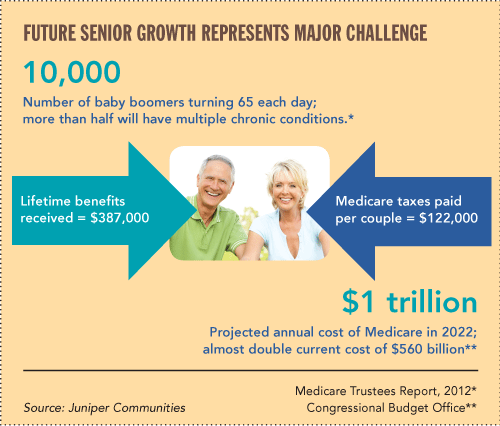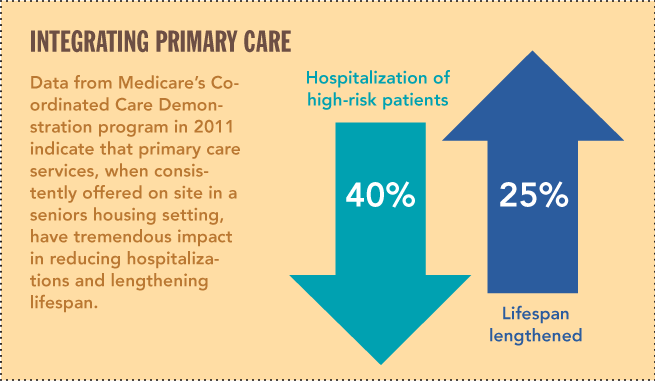B
y 2030, nearly one-quarter of Americans will be over age 65, and almost half will be well beyond age 75, according to the U.S. Census Bureau. This monumental shift in national demographics is driving change across almost every facet of the health care industry.
From acute and primary care to senior living and ancillaries, health care organizations are shifting strategic focus, exploring new models of care and fundamentally altering the way they will both pay for and deliver it in the next 30 years.
Health care costs as a portion of gross domestic product have grown from a meager 4.4 percent in 1950 to a stagger-ing 17.9 percent in 2011, according to the World Health Organization. Left unmanaged, it could exceed 30 percent by 2040, plunging the nation into economic chaos, one Senate document warns.
Catching The Aging Wave
Given the sheer size of America’s aging wave and the volume of chronic illness inherent in that population, it’s no surprise that much of the shifting emphasis has focused on senior health care. National expenditures for elder care alone are likely to exceed $1 trillion annually by 2025, according to the Congressional Budget Office.
The current infrastructure for aging care and service is historically detached from other providers, largely uncoordinated and prone to highly variable use and costs. For senior health care organizations, achieving the triple aim of better health, better care, and lower costs means thinking outside the traditional box.

What this means for senior living providers is a dramatic shift in how they manage and coordinate operations. They must develop new models, foster innovative connections to other providers, and ultimately take risk, on their own and with others, to emerge as desirable partners in a greatly integrated future landscape. Essentially, senior living must come of age.
Independent and assisted living (IL and AL) are emerging as an essential component of a comprehensive elder population health model:
■ IL and AL typically support elders over much longer time frames than other health care settings (commonly 22 months in AL per an NCHS Data Brief from the Centers for Disease Control and Prevention) and longer in IL settings;
■ IL and AL provide a stable physical environment where supportive services and health management techniques can be introduced proactively to address multiple dimensions of health (physical, social, mental, and spiritual); and
■ The concentrated population density of senior housing campuses is potentially appealing to both accountable and managed care organizations, which will inevitably pay for services to support proactive models and avoid higher-acuity, more-expensive settings in the future.
Senior living is positioned to support the triple aim on the front end—before an acute hospitalization episode might ever begin.
Three Keys To Success
Key components for successful integrated care in senior living are threefold:
■ Using data and outcomes to drive quality, define performance, and guide operations;
■ Integrating primary care physicians directly into AL settings via a patient-centered medical home model; and
■ Cultivating well-being through therapy-driven physical wellness programming and seamless access to other services through strategic partnerships and alliances.
For residents and prospective customers, this model emphasizes a richly active and engaged approach to healthy aging. For accountable care organizations and similar risk-management organizations, this represents a delivery innovation for senior care that bears greater examination and exploration around improving beneficiary health while managing total cost of care.
Data Rather Than Anecdotes
At Juniper Communities, in Bloomfield, N.J., intentional use of data and outcomes has defined the organization’s operational practices and innovative program development for more than a decade.
Each Juniper community documents and trends more than 90 quality measures across five domains (including most of the National Center for Assisted Living clinical performance measures), many focused on physical health intensities and conditions. Urinary tract infections, falls, wounds, and changes in resident status—among many other measures—are central to monitoring each community’s clinical profile and identifying trends for intervention or improvement.
Cross-tabulation comparisons are particularly informative. A decline in a particular outcome measure (like an increased number of skin tears) is usually informed by a shifting process measure (like volume of skin assessments completed). Using data rather than anecdotes or speculation, community and regional staff drive to the root of problems and create proactive corrective actions.
Borrowing From The PCMH Model
As expanded data inform better care and outcomes, improving access to primary care is a fundamental adjunct to achieving better health. The primary care office visit represents one of the least expensive forms of elder care (typically around $120 per visit) and is seen by many as a keystone for truly integrated care. Emergency department costs, in comparison, can vary between $600 and $1,000 per visit. Physician services offered specifically in senior living are particularly compelling.
To accomplish the integration of primary care, Juniper has developed Redwood Health Partners—a comprehensive primary care practice organization with clinic settings based inside its senior living communities. Built around the patient-centered medical home (PCMH) model, Redwood practitioners keep regular office hours at on-site clinics and are specifically trained to care for senior living residents.
Assessments and other planned visits are scheduled on a routine basis. Redwood staff are integrated with other Juniper staff to coordinate service and care plan development. Redwood physicians, who document all patient encounters directly in Juniper’s electronic health record (EHR) platform, can intervene early to avoid costly and debilitating escalation and mitigate the likelihood of an unnecessary emergency room visit or inpatient hospitalization.
The inherent “medical concierge” function of the PCMH model is additionally desirable for residents and families, who have better access to health information.
Folding In Wellness
Achieving better health for older adults (and ultimately decreasing costs) will depend heavily on cultivating well-being through expanded programs and partnerships, essentially crafting a multi-pronged approach to wellness—physical health, mental and spiritual wellness, and social interaction.

Physical wellness, in particular, however, represents a core area for customers who want to maintain a healthy quality of life that supports an active and independent lifestyle.
To accomplish this key component of integrated care, Juniper Communities has recently engaged in a relationship with Genesis Rehab Services in Kennett Square, Pa., to integrate comprehensive therapy services into its physical wellness offerings. Genesis therapists and Juniper staff are working together to create Theralink—a rehab and fitness culture that celebrates “active bodies.”
Genesis and Juniper have collaboratively developed a series of physical wellness and therapy protocols that create specific measures and outcomes that, in effect, establish Juniper’s definition of “well-being.” As a resident’s condition changes and is reflected in a changed measure (well-being improves or declines), Theralink prescribes specific services or interventions to improve or enhance the resident’s status.
Because Genesis therapists are integrated members of the community wellness teams, interventions are virtually immediate and preclude a slow accumulation of problems that might lead to an unnecessary or expensive hospitalization.
Lynne Katzmann is founder and chief executive officer of Juniper Communities. She can be reached at lynne.katzmann@junipercommunities.com. Don Breneman is vice president of risk management and business operations at Juniper, and Diane Byrne is vice president of program development, training, and operational oversight.